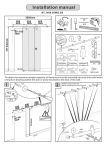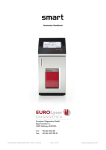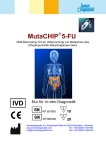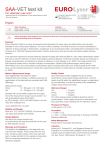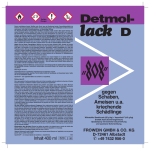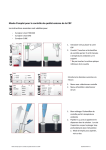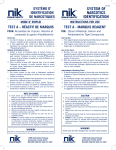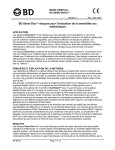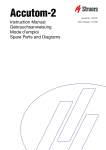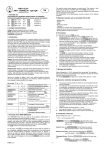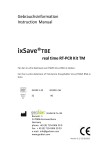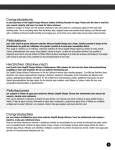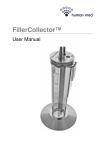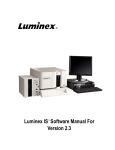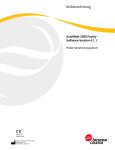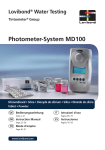Download solo T4-Vet Test
Transcript
solo T4-Vet Test For vet use only! In Vitro Diagnostic test kit for determination of T4 with solo analyser. Eurolyser Diagnostica GmbH Bayernstraße 11 a 5020 Salzburg/Austria Tel. +43 (0)662 / 43 21 00 Fax +43 (0)662 / 43 21 00-50 www.eurolyser.com Indication Kit size English Order Information Order number: VT 01 40 Order number: VT 1 400 solo T4-Vet-Test Kit solo T4-Vet-Control Kit 1 6 tests/pack 2 x 1 ml (low high range) Test kit preparation: Allow single test min. 1 0 minutes to warm to room temperature by placing the test into the test kit rack. Put test kit package back into refrigerator. Summary Thyroxine (T4) is produced by the thyroid. Controlled by a complex regulatory mechanism it is released into the bloodstream. Most of the thyroxine in blood is bound to various carrier proteins such as albumine, prealbumine and other specific binding proteins. Diseases of the thyroid with abnormal hormone concentrations occur more likely in older animals. Elevated or lowered concentrations of the thyroid hormones, e.g. thyroxine (T4), lead towards problems in numerous other systems. Hyperthyreosis are merely found in cats, hypothyreosis are found in all species. Methode The solo T4-Vet test is a homogenous encymatic immunoassay. By using an 8-anilino-1 -naphtaline acid sulfure (ANS) the bound T4 is seperated from its binding proteins. The seperated thyroxine released from blood competes afterwards with a thyroxine that is linked to the Glucose-6-phosphat dehydrogenase enzyme to a specified binding area. The GAPDH activity at 340nm is associated with the complete thyroxine concentration in blood. If no T4 is in the blood sample the enzyme activity is inhibited by the binding of a specific antibody. Sample material Serum or plasma (EDTA, Heparin, Citrat). Samplevolume according to the menu settings on solo and according to the use of a 20µl or 5µl pipette. Stability and Storage Store at 2 - 8°C. DO NOT FREEZE. Kit can be used until expiry date printed on the labels. Waste Management Please refer to local legal requirements. Normal Ranges Dog Cat Pets Horse Cattle Precision cv < 4% at 1 ,03µg/dl Measurement Range Correlation Warnings References When using a 20µl pipette: 0-8 µg/dl (0-96 nmol/l) When using a 5µl pipette: 8-40 µg/dl (96-580 nmol/l) This testkit is for in vitro diagnostic use only. Do NOT INGEST. Avoid contact with skin and eyes. Contains sodium azide, which may react with lead or copper plumbin to form explosive compounds. Take the necessary precautions for the use of laboratory reagents. 1 ,3-4,5 µg/dl (1 5-54 nmol/l) 1 ,0-4,0 µg/dl (1 2-48 nmol/l) 0,8-2,5 µg/dl (1 0-30 nmol/l) 1 ,3-4,1 µg/dl (1 5-49 nmol/l) 3,8-8,2 µg/dl (46-99 nmol/l) solo T4 (µg/dl) =0,9532 x Immulite T4 + 0,1 827 R²=0,91 ; N=24 dogs,1 2 cats; Mean=2,1 9 µg/dl 1 . Penny, M., O’Sullivan, J. 1 987. Clin Chem 33: 1 701 71 . 2. Harris, P., Marlin, D. Gay, J. 1 992. Equine thyroid function tests: a preliminary investigation. Br Vet J 1 48: 71 -80. 3. Thoresen, S.I., Wergeland, R., Moerkrid, L., Stokke, O. 1 996. Evaluation of an enzyme immunoassay for free Thyroxine determination in canine serum. 1 996. Vet Res Com 20: 411 -420. solo T4-Vet Test Nur für veterinär Gebrauch! Testkit für die quantitative in vitro Bestimmung von T4 am solo Analyser. Eurolyser Diagnostica GmbH Bayernstraße 11 a 5020 Salzburg/Austria Tel. +43 (0)662 / 43 21 00 Fax +43 (0)662 / 43 21 00-50 www.eurolyser.com Bezeichnung Packungsgröße Deutsch Bestellinformation Bestellnummer: VT 01 40 Bestellnummer: VT 1 400 solo T4-Vet-Test Kit solo T4-Vet-Control Kit 1 6 Tests/Packung 2 x 1 ml (low/high) Vorbereitung des Testkits: Der Einzeltest muss mindestens 1 0 Minuten auf Raumtemperatur aufgewärmt werden. Geben Sie dazu den Test aus der Packung und setzen Sie ihn in das Testkit-Rack. Geben Sie die Testpackung zurück in den Kühlschrank. Zusammenfassung Thyroxin (T4) wird in der Schilddrüse gebildet und über einen komplexen Regulationsmechanismus in die Blutbahn frei gegeben. Das meiste Thyroxin ist im Blut an verschiedene Trägerproteine wie Albumin, Präalbumin und anderen spezifischen Bindeproteinen gebunden. Erkrankungen der Schilddrüse mit abnormalen Hormonkonzentrationen treten vor allem bei älteren Tieren häufiger auf. Erhöhte bzw. erniedrigte Konzentrationen der Schilddrüsenhormone wie z.B. Throxin (T4) führen zu Störungen zahlreicher anderer Organsysteme. Hyperthyreosen werden vor allem bei Katzen, Hypothyreosen werden bei allen Spezies beobachtet. Methode Beim solo T4-Vet Nachweis handelt es sich um einen homogenen Enzym Immunoassay. Mit Hilfe von 8-anilino1 -Naphtalin Schwefelsäure (ANS) wird das gebundene T4 von seinen natürlichen Bindeproteinen gelöst. Das so gelöste Thyroxin aus dem Blut kompetitiert anschließend mit einem Thyroxin, das an das Enzym Glucose-6phosphat Dehyrogenase gekoppelt ist um eine spezifische Bindestelle. Die GAPDH Aktivität bei 340 nm ist dadurch mit der Gesamt Thyroxin Konzentration im Blut assoziiert. In Abwesenheit von T4 in der Blutprobe ist die Enzymaktivität durch die Bindung eines spezifischen Antikörpers inhibiert. Probenmaterial Lagerung und Haltbarkeit des Testkit Bei 2 - 8°C gelagert, bis zum aufgedrucktem Haltbarkeitsdatum verwendbar. NICHT EINFRIEREN. Entsorgung Bitte beachten Sie die jeweiligen gesetzlichen Vorschriften. Normalbereich Hund Katze Heimtiere Pferd Rind 1 ,3-4,5 µg/dl (1 5-54 nmol/l) 1 ,0-4,0 µg/dl (1 2-48 nmol/l) 0,8-2,5 µg/dl (1 0-30 nmol/l) 1 ,3-4,1 µg/dl (1 5-49 nmol/l) 3,8-8,2 µg/dl (46-99 nmol/l) Serum oder Plasma (EDTA, Heparin, Citrat) . Probenmenge entsprechend der Menüeinstellung am solo und Verwendung der 20µl oder 5µl Pipette. Präzision Messbereich solo T4 (µg/dl) =0,9532 x Immulite T4 + 0,1 827 R²=0,91 ; N=24 Hunde,1 2 Katzen; Mean=2,1 9 µg/dl Bei Verwendung der 20µl Pipette: 0-8 µg/dl (0-96 nmol/l) Bei Verwendung der 5µl Pipette: 8-40 µg/dl (96-580 nmol/l) Warnungen und Vorsichtsmaßnahmen Die Reagenzien beinhalten Natriumazid als Konservierungsmittel. Nicht verschlucken! Berührung mit Haut und Schleimhäuten vermeiden. Beachten Sie die notwendigen Vorsichtsmassnahmen für den Gebrauch von Laborreagenzien. cv < 4% bei 1 ,03µg/dl Korrelation Referenzen 1 . Penny, M., O’Sullivan, J. 1 987. Clin Chem 33: 1 701 71 . 2. Harris, P., Marlin, D. Gay, J. 1 992. Equine thyroid function tests: a preliminary investigation. Br Vet J 1 48: 71 -80. 3. Thoresen, S.I., Wergeland, R., Moerkrid, L., Stokke, O. 1 996. Evaluation of an enzyme immunoassay for free Thyroxine determination in canine serum. 1 996. Vet Res Com 20: 411 -420. Durchführung solo T4-Vet Test Processing of solo T4-Vet test 1. 1 .1 1 .2 1 .3 1 .4 2. 2.1 a oder/or 2.1 b 2.2 3. 3.1 3.2 3.3 3.4 Deutsch English 1. Testsystem vorbereiten 1. Prepare testsystem 2. Für weitere Details beachten Sie bitte das Anwenderhandbuch des solo Analyser 2. For further details please refer to the according section in the solo user manual: 1 .1 1 .2 1 .3 1 .4 RFID-Karte einsetzen ERS Küvette in Probenhalter geben ERS Kappe in Probenhalter geben Mess-Taste drücken, die erforderlichen Daten über das Touch Display des Analysers eingeben 1 .1 1 .2 1 .3 1 .4 Insert RFID-card into analyser Place ERS cuvette into solo testkit rack. Place ERS cap into solo testkit rack. Press symbol on touch screen, required information is entered by use of the touch display of the analyser Auswahl der Probenart: 2.1 a 20µl Pipette: Möglicher Messbereich: 0-8 µg/dl (0-96 nmol/l) ODER... 2.1 b 5µl Pipette: Möglicher Messbereich: 8-40 µg/dl (96-480 nmol/l) 2.2 Start der Analyse durch Drücken des Start Buttons Choose sample type: 2.1 a 20µl pipette: Possible measuring range: 0-8 µg/dl (0-96 nmol/l) OR... 2.1 b 5µl pipette: Possible measuring range: 8-40 µg/dl (96-480 nmol/l) 2.2 Start of analysis by pressing the start button ACHTUNG! WARNING! 3. 3. Die Pipettenspitze nach der Probenentnahme NICHT abwischen! Tests 1 0 Minuten vor Gebrauch bei Raumtemperatur aufwärmen lassen! 3.1 3.2 3.3 3.4 3.5 Do not wipe pipetting tip after sample collection! Allow test minimum 1 0 minutes to warm up to room temperature before inserting the test into the analyser! Probenvorbereitung Serum oder Plasma (Serum Primärröhrchen, Lithium-Heparin oder EDTA Plasma) 20µl bzw. 5µl Serum/Plasma aus Primärgefäß pipettieren 20µl bzw. 5µl Probe in ERS Küvette IN FLÜSSIGKEIT pipettieren ERS Kappe fest auf ERS Küvette aufsetzen ERS Cartridge in solo Analyser einsetzen Start der Analyse durch drücken des Start buttons. Sample preparation serum or plasma (serum primary tube, lithium-heparin or EDTA plasma) 3.1 Pipette 20µl or 5µl serum/plasma from primary tube 3.2 Pipette 20µl or 5µl sample into ERS cuvette INTO LIQUID 3.3 Place ERS cap firmly on ERS cuvette 3.4 Place ERS cartridge into solo analyzer 3.5 Start automatic sample processing by pressing the start button. VET ; T4 ; revD2




